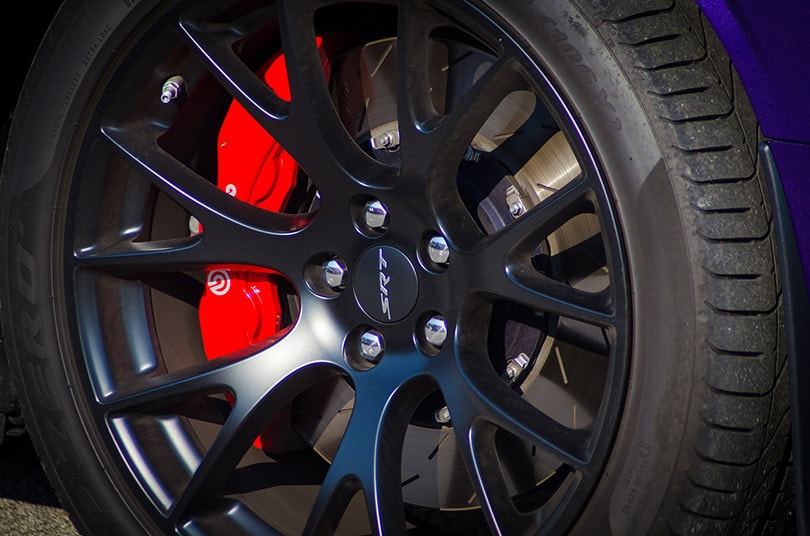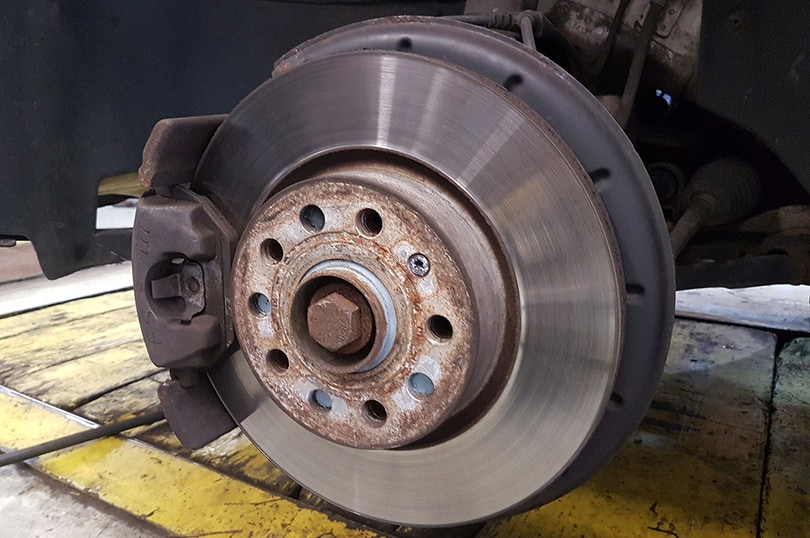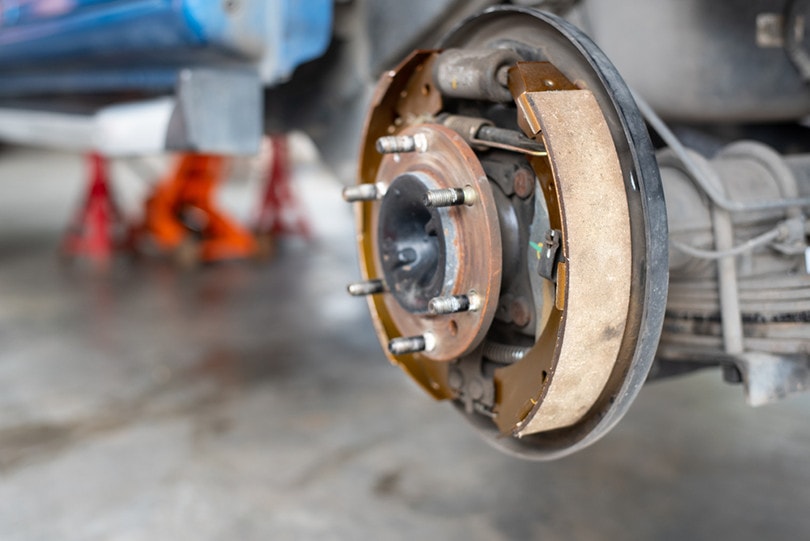4 Different Types of Car Brakes
-
Ed Malaker
- Last updated:

The battery is arguably the most important part of any vehicle, so it makes sense to learn as much as you can about the different types available so you can quickly identify any problems and know what you need to make repairs. Keep reading as we go over several types of brakes that you are likely to find on your automobile and discuss how each one works and when you use them.

The 4 Types of Car Brakes
1. Disc Brakes

| Characteristics: | Replaceable brake pads, calipers, rotors, pistons |
| Use: | Front brakes on most vehicles, back brakes on some others |
Disc brakes are the most likely to need changing, and you will likely need to replace them several times over the life of your car. You can find these brakes on the front tires, and they wear down quickly because every time you stop your car, all its weight shifts to the front, so these brakes get the most use. Many cars also use them as back brakes.
These brakes work using hydraulic pressure. Two replaceable brake pads are placed on either side of a caliper over a rotor attached to the tires. When you press on your brake pedal inside the car, hydraulic pistons on either side of the caliper push the brake pads into the rotors, which causes the friction required to stop the vehicle. The pistons can only move a short distance, so the pads aren’t too thick, and they wear down after a while, which is why you need to replace them. You may also need to change the rotors occasionally, as they can also wear down or get rusty, but the calipers and pistons will usually hold up well with minimal maintenance.
Cost
The cost of the brake pads is fairly low, and there are several types. Most people can change the pads easily by removing the front tires. The rotor is also inexpensive and easy to change, and it slides over the lug nuts behind the tire. Any calipers and brake line maintenance is better left to an auto mechanic, and the cost will be higher.
- Easy to replace
- Work well
- Frequently need changing
2. Drum Brakes

| Characteristics: | Replaceable brake pads, wheel cylinder, drum, pistons |
| Use: | Large vehicles, back brakes on many vehicles |
Drum brakes were the original brakes used on vehicles until the 1960s, when disk brakes became more popular due to their superior stopping power. However, drum brakes are still quite popular as back brakes, and many cars still use them.
Drum brakes are similar to disk brakes in components, but they operate differently. They use an iron drum instead of a rotor. The brake pads sit inside, and a wheel cylinder uses pistons to push the pads outward against the drum to create the friction required to stop the car.
Cost
Like disk brakes, the cost of drum brakes is fairly low, but you will usually take these to a mechanic to get repaired. Since most of the braking occurs at the front of the car when the weight shifts, back brakes can last a long time and don’t require changing nearly as frequently.
- Long-lasting
- Work well
- Not DIY friendly
3. Emergency Brakes

| Characteristics: | Bypass hydraulic system to apply brakes |
| Use: | Prevent the car from moving when not applying the brakes |
The emergency brake is not a unique system like disk or drum brakes. Instead, it is a manual system that bypasses your powered hydraulic system to enable you to apply your brakes while the car is not running. Almost all systems use a cable that pulls the pads against the rotors or drum. People commonly use it as a parking brake to keep the car safe when they are not in it, but it is also a safety device that will enable you to stop the car if the brakes fail.
The cable that tightens the brakes is usually attached to a lever between the front seats, but other methods exist. For example, trucks and older vehicles often use a pedal that you push and a handle that you pull to release the brake.
Cost
The cable that pulls the brakes tight against the rotors or drums is under great strain, and it can wear out occasionally, especially if you need to park on an incline regularly. The cable is not overly costly to repair and is a simple job, but you will usually need to take it to an auto mechanic for repairs.
- Prevent the car from rolling uncontrolled
- Provide additional safety
- Not DIY friendly
4. Anti-lock Brakes
| Characteristics: | Have a safety mechanism that prevents skidding |
| Use: | Improve handling and control of your vehicle |
Like the emergency brake, anti-lock brakes are part of a system that improves how standard brakes work. Anti-lock brakes work by using a sensor on each tire that works with the car’s electronic stability control computer to detect when a wheel is about to lock up when you suddenly apply the brakes. If it senses a problem, it begins rapidly increasing and reducing braking pressure to that tire, which enables it to keep rotating while slowing the car, increasing driver control. This system is essential when driving on slippery roads, where it is common for people to slam on the brakes in a panic. People also tend to slam on the brakes in response to something in the road, like a deer or a stopped car, and anti-lock brakes will help the driver maintain control in both situations. However, they work better on a dry surface.
Cost
Unfortunately, repairing a malfunctioning anti-lock brake system requires a qualified technician to get into the vehicle’s computer to see where the malfunction is taking place, which is often more expensive than changing brake pads, and it’s not DIY friendly.
- Prevent the car from rolling uncontrolled
- Additional safety
- Not DIY friendly

Why Are My Brakes Squealing?
It’s Time to Change Them
Brake pads have a design that causes them to start squealing when they get too thin and it’s time to replace them. The noise helps alert the driver that there is an issue, which reduces the risk of brake failure. If you hear a consistent squeal from your brakes, especially when you are not applying them, it’s time to have them looked at by a qualified technician.
Moisture and Dust
If you have recently changed your brakes, but you still hear squealing, there is a good chance that it results from moisture and dust. Brakes create a significant amount of dust, and moisture can cause the dust to adhere to the brake pads, resulting in squealing when you apply the brakes. Squealing occurs because the new brake pads have a smooth surface and the dust has nowhere else to go, but it will subside once the brake pads wear in a little.

Summary
There are several types of brakes, and there is a good chance that you have each one in your vehicle. Even many modern cars that use disc brakes on all four tires have at least one drum brake for a better emergency brake, and every car should have a working emergency brake and anti-lock brakes, as they are standard on most vehicles.
You may also be interested in:
- My Car Shakes When Braking: 6 Common Problems & Solutions
- Car Maintenance: 11 Crucial Tips to Keep Things Running
- 7 Different Types of Car Accidents
- DO YOU HAVE TO BLEED BRAKES AFTER CHANGING PADS?
- HOW LONG DOES IT TAKE TO CHANGE BRAKE PADS?
Featured Image Credit: coltsfan, Pixabay
Contents
